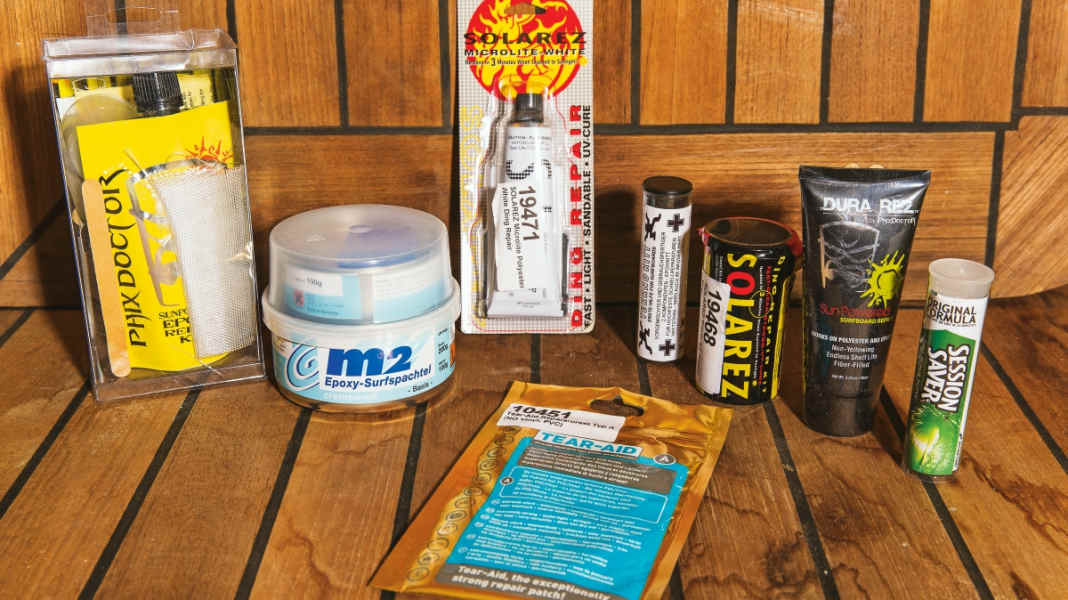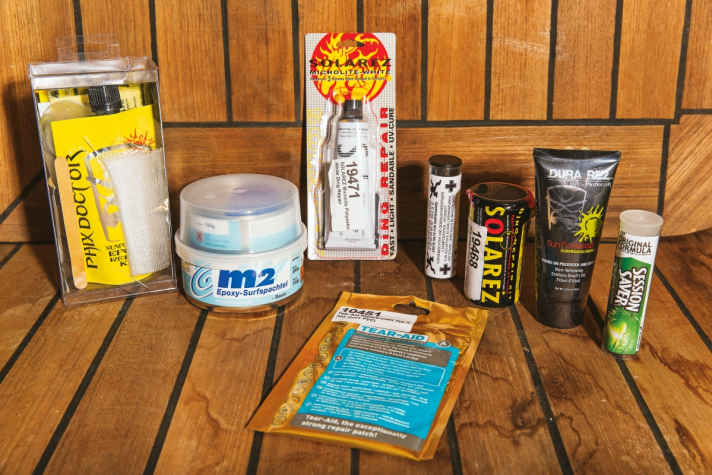
Board repairs are not rocket science, but there are still areas of the board that are better left to the experts. This is the case:
- For soft spots or damage in the standing area
- For cracks or soft spots under the pads, on the rails under the pads and on the foil box.
- In the event of major damage where the polystyrene core has been damaged
- When the look needs to be perfect.
In the following, we will show you which common quick repair kits you should always have with you, what the materials can do - and what they cannot.
Laminating or quick repair?
The decisive factor for durability when repairing boards is always the fabric, never the adhesive used. Therefore, the following applies: A quick repair is sufficient for small holes and imperfections (see below for materials); larger tears in the fabric should be laminated. Complete sets are ideal for occasional repairs or when travelling. These sets are available in many (online) surf shops.
The polyester trap
Repair kits for polyester and epoxy are available to buy. Wingsurf boards are laminated with epoxy resin, boats or kayaks are often laminated with polyester resin. Polyester is somewhat more brittle and hardens more quickly, but attacks the foam cores of surfboards, which can lead to a larger hole in the board afterwards than before. You should therefore always opt for epoxy resins!
The best materials for quick repairs on wingsurf boards
You don't always have to laminate - small holes can be patched without hesitation using the following materials. Find out the advantages and disadvantages of the individual products and which ones should definitely be in your board bag before your next trip:

Group 1: Two-component kits
Ding Stick (without picture), Session Saver (2), Tekkno Stick (1) or Gumball (3) - many names, but the same thing is hidden behind them: A two-component kit from which you cut off a piece, knead it until the mass turns white and seal the area with it. Important: Sand beforehand and moisten your fingers a little!
Mixing ratio automatically correct; also hardens in water; independent of UV radiation; quick-drying (approx. 15 minutes); no sanding required
Longer drying time in cold weather; not very durable for extensive repairs
Source of supply: In almost every surf shop
Conclusion: Indispensable where you can't always rely on the sun!
Group 2: UV-curing materials
Solarez (4/5), Dura Rez (6) and the Phix Doctor Set (7) are based on UV-curing epoxy. The Phix Doctor set also includes glass mats and accessories for larger repairs. Dry the area, sand and apply the material in the shade. The resins are mixed with microballoons - a filler made of small glass fibre shreds - and the resin can be smoothed out with the films supplied (hardly any sanding necessary). Only then expose to the sun.
hardens within a very short time (2-5 minutes in direct sunlight); temperature-independent; also suitable for filling deep holes that are to be laminated afterwards; permanent repair
Often very delayed curing in moderate sunlight
Source of supply: In the surf shop or HERE
Conclusion: The best choice when travelling south! A two-component kit is perfect as a supplement.
Group 3: Other adhesive materials
Tear Aid (8): PVC adhesive film, which - according to the manufacturer - should also be suitable for surfboards. Sand the area, degrease with the enclosed alcohol wipes, stick on, done!
independent of sun & temperature
not very durable in the underwater hull and on the deck (non skid paint); does not provide strength.
Source of supply: www.tt-project.com
Conclusion: Less recommended for surfboards, good for inflatable wingfoil boards.
Group 4: Superglue
For example from Conrad: Reacts within seconds due to the moisture in the air. Use pure for small hairline cracks, otherwise in combination with "filler for superglue".
extremely fast; independent of sun and temperature
Be careful with deep holes: Contact with the foam core will dissolve it!
Source of supply: DIY store & model making
Conclusion: All-purpose weapon for hairline cracks!
Group 5: Epoxy putty
M2 epoxy fillerMix (10) and hardener in a ratio of 2:1, smooth over the area (old EC cards are perfect) and allow to harden.
good sandability and recoatability
Longer drying time in cold weather; not permanent for extensive repairs
Source of supply: Surfshops & www.ascan.info
Conclusion: Actually only suitable for finishing, but the bottom line is that it's too cumbersome!

